 |
World History
The Swan’s Song of Galileo’s Myth
Atila Sinke Guimarães
It became common in innumerable revolutionary milieus to criticize the Holy Inquisition, and by extension the Catholic Church, for the condemnation of Galileo. The progressivists endorse such critiques, and repeat the catchphrase – the obscurant Church condemned science. They are quick to add that such condemnation would prove that the Magisterium of the Church is not infallible (1). Then, the progressivists assume another consequence: Galileo was condemned for applying scientific data to the exegesis of Holy Scripture. Since this condemnation was supposedly unjust, it would be valid to use scientific data either to alter the interpretation of Scripture, or even to demonstrate that it is wrong.
These arguments are sophistic, taking advantage of the confused boundaries among science, philosophy, and theology that existed at the beginning of the 17th century. Such confusion can be verified not only in the texts of Galileo, but also in the sentence of his condemnation (1633). Galileo extrapolated scientific data and made conclusions in the fields of philosophy and theology, allegedly supposing both to be in the realm of science. The judges of the Inquisition made a parallel confusion when they condemned the scientific theories of the scholar, thinking that they were condemning the unsuitable philosophical and theological extrapolations of Galileo.
That is, both sides based their conclusions on a fundamental imprecision of terms as we understand them today. That imprecision is what fed the myth that the Church condemned science. All the ensuing attacks against the Inquisition and the Catholic Church have been made without taking this basic confusion into consideration.
Such confusion was pointed out by Fr. Mario Vigano, SJ, a scholar in History, who supports E. Berti, another Italian historian, when he dealt with the relations between science and faith. Vigano wrote:
“Berti’s point is that the problem of the relation between science and faith cannot be resolved by analyzing exclusively the two terms in question. The problem must be considered from a perspective that is neither that of faith nor of science, but rather that of philosophy. ….
For Galileo and the theologians of his time, this problem did not exist because there was no distinction between science and philosophy” (2).
1. Charles Journet, L’Église du Verbe Incarné, (Desclée de Brouwer, 1955), vol. 1, pp. 458-62.
2. Mario Vigano, “Galileo ieri e oggi,” La Civilta Cattolica, September 1984, p. 388.
It is indispensable, therefore, to know precisely what each party intended in that discussion. Let me analyze the historic data in order to set straight the confused situation.
Was the Church against science in the 17th century?
There is no direct evidence that the Inquisition had the intention to attack science as such when it made the condemnation of Galileo. Several facts can be listed to support this position:
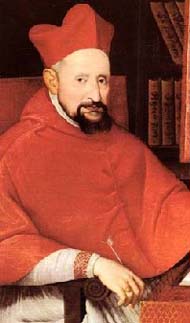
St. Robert Bellarmine warned Galileo not to issue dogmatic statements on theology |
• The Inquisition had various advisers, several of them from the Roman College of Jesuit scholars, which had a division on Mathematics specialized in scientific matters. This College had maintained cordial relations with Galileo for a considerable time, and warmly welcomed him during his visit to Rome in 1611.
• Important scientists such as Frs. Clavio, Scheiner, and Grassi were members of the famed College.
• St. Robert Bellarmine acknowledged the seriousness of the Roman College by consulting several times to know the scientific value of Galileo’s theories.
• In response to one of St. Bellarmine’s questions, Fr. Clavio affirmed that the proofs of Galileo “were more probability than established fact” (3).
• One of the arguments that failed to convince the scholars was his argument that the tides were moved by the moon, a theory based on considerations that were “merely qualitative and not quantitative,” making it an “inadequate” argument (4).
The initial favorable position of the Roman College to Galileo, the seriousness of its scholars, the confidence St. Robert Bellarmine placed in their opinion, and its specialized department of science do not present a picture of an institution opposed to the advancement of science, as presented by the revolutionary and progressivist myth.
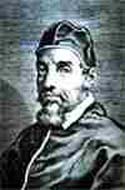
Pope Urban VIII - initially favorable to Galileo |
Moreover, Pope Urban VIII was linked to Galileo by a personal friendship. Soon after he was raised to the Pontifical Throne, Urban VIII highly praised Galileo’s book Il Saggiatore and gave it an imprimatur (5). In that work Galileo sustained a polemic with Fr. Grassi from the Roman College regarding three comets that appeared in 1417 (6). Once again, it reinforces the idea that the Church was an impartial party in the scientific debate of that time.
3. Ibid. p. 392.
4. Ibid. p. 383.
5. Ernest Lavisse and Alfred Rambaud, Histoire Générale du 4eme Siécle à nos Jours (Paris: Armand Collin, 1895), vol. 5, p. 485.
6. Ibid.
Galileo’s obsession with changing Philosophy
In 1616 the Holy Inquisition issued its first condemnation of Galileo’s hypothesis of heliocentrism, which added new data to Copernicus’ theory (7). The advisors of the Inquisition did not base their judgment, however, on the scientific data Galileo presented, much less did they condemn Copernicus. They declared that the propositions presented were “stultified and absurd regarding philosophy” (8).
In fact, Galileo, went beyond the field of science, claiming that his discoveries meant “the funeral or, better, the final judgment for pseudo-philosophy” (9). That is, he was not just stating a hypothesis and offering scientific arguments; he imagined himself abolishing the Aristotelian-Thomist philosophy in force at the time.
In a letter to the Grand Duchess Christina of Lorraine, Galileo obstinately insisted that he wanted to speak not as a mathematician, but rather with an absolute sense, as a philosopher. Otherwise, he asserted, science would be missing its principal aim (10). He acknowledged, therefore, that what he was proposing went beyond the scientific realm and impinged directly upon that of philosophy.
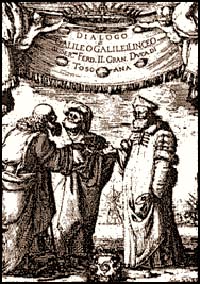
In the Dialogo (shown above), Galileo ridiculed Thomist philosophy |
Pope Urban VIII only broke his good relations with Galileo when the latter wrote the book Dialogo, or Massimi Sistemi, in which he tried to ridicule the Aristotelian-Thomist philosophy in dealing with the systems of Ptolemy and Copernicus. Only then, in 1633, did the Pope deliver him to be judged by the Holy Inquisition for the second time (11).
He was judged and politely obliged to abjure his errors. Galileo himself acknowledged that he was treated indulgently by the Inquisition throughout the affair. The condemnation prescribed prison, but it was not put in practice. He passed the year 1633 with the Archbishop of Sienna. Afterward, he was allowed to live in the beautiful villa Arcetri, near Florence, where he soon recovered entire liberty. He was never prevented from pursuing his studies and investigations in science (12).
If Galileo had not left the field of science, therefore, and entered the realm of philosophy, most probably he would have continued to enjoy the favor of Pope Urban VIII and avoided problems in advancing his scientific discoveries. Fr. Mario Vigano confirms this:
“If he would have realized that the object of science is restricted to mathematics and the laws of nature, he would have had no difficulty in following the counsels of Bellarmine and the Academy of Lincei, as well as the injunctions proposed by Urban VIII in his writing of Dialogo. With this, he would have avoided so many troubles” (13).
The condemnation of the Holy Inquisition, therefore, should not be seen as a prohibition of the Church regarding science, but rather, philosophy. If the condemnatory decree did not mention philosophy explicitly, this was because at that time the distinction between both matters was not entirely defined. The intention of the condemnation, however, seems quite clear.
7. Ibid. p. 484.
8. M. Vigano, “Galileo ieri e oggi,” , p. 388.
9. Agostino Favaro, Opere di Galileo, vol. 11, p. 296, apud ibid., p. 387.
10. Lettera a Cristina di Lorena, apud A. Favaro, Opere di Galileo, vol. 5, p. 229-30, apud ibid., p. 388.
11. E. Lavisse and A. Rambaud, Histoire Générale du 4eme Siécle à nos Jours (Paris: Armand Collin, 1895), vol. 5, p. 486.
12. Ibid.
13. M. Vigano, “Galileo ieri e oggi,” p. 387.
The theological pretensions of Galileo
But Galileo did not limit himself to attacking Aristotelian-Thomist philosophy. Leaving the terrain of science, he went further and entered the realm of theology as well. To harmonize them with the Copernican theory, he proposed to modify the traditional interpretation of various texts of Scripture that mentioned the movements of the sun and earth. Further, he proposed that Scripture sustained errors.
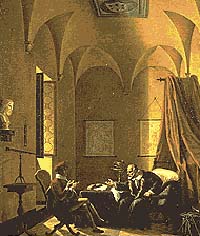
Galileo enjoyed comfort and almost full freedom after his condemnation |
Galileo was warned to avoid such interpretations by his fellow scientist Cesi, who wrote him and reported his conversation with Cardinal Maffeo Barberini. Via Cesi, the Cardinal counseled caution, advising Galileo not to delve beyond questions of a purely mathematical nature, because “it is up to the theologians to explain Scriptures.” After transmitting this wise counsel, Cesi himself warned Galileo that he was endangering matters of Faith by defending such novelties (14).
Cardinal Dini, an eminent theologian consulted by Galileo, told him:
“Despite the fact that the theory of Copernicus is ‘plausible,’ it has not yet been proven. .… He merely presented his theory as a mathematical hypothesis. At any rate, it is prudent not to throw yourself into theological quarrels regarding the denial of the texts of Scripture” (15).
Galileo had a friend, the Carmelite Fr. Paolo Antonio Foscarini, who defended analogous positions. In 1615 St. Robert Bellarmine wrote a letter to this priest, and indirectly to Galileo, in which he offered his possible support for the scientific theories in question should they be adequately demonstrated. At the same time, however, he expressed his concern about the theological consequences included in the question. He wrote:
“I say to you that it seems to me that Your Reverence would act prudently to content yourselves with speaking ex suppositione [hypothetically] and not in an absolute manner, as I have always believed Copernicus spoke. For to say that you suppose the earth moves and the sun stands, all the appearances are saved better than eccentricities and reversals. This does not present any danger and is proper for mathematicians. But to want to affirm that the sun really is fixed in the center of the heavens and only revolves around itself …. is a very dangerous thing, not only by irritating all the philosophers and scholastic theologians, but also by injuring our holy Faith and accusing Holy Scriptures to be false ….
“But I tell you that if there were a true demonstration that the sun was the center of the universe .... that the sun did not travel around the earth but the earth circled the sun, then it would be necessary to proceed with great caution in explaining the passages of Scripture that appear contrary. And we would rather have to say that we did not understand them than to say that something was false which has been established.” (16).
One can see that Galileo, even though warned by a Pope, a Saint, a Cardinal and various eminent scholars, persisted in assuming the role of reforming exegesis. With this extremely arrogant attitude, he in effect provoked the condemnation of his theological pretensions.
Instead of a serious scholar and precise scientist, Galileo presented himself as a rebel theologian applying the method of the free-examination that Luther had fabricated some 50 years before. Actually, he quite deserved the condemnation he received.
14. A. Favaro, Opere di Galileo, vol. 12, p. 146, apud M. Vigano, “Galileo ieri e oggi,” p. 381.
15. A. Favaro, Opere di Galileo, vol. 2, p. 155, apud E. Vacandard, entry Galilée, Dictionaire de Theologie Catholique, vol. 6, col. 1061.
16. Ibid., col. 1062.
A just condemnation recognized by many
The Holy Inquisition, therefore, acted correctly in condemning Galileo. That action was consistent with its mission of guarding the integrity of the Catholic Faith. It was justly defending the Catholic Theology and Philosophy attacked by Galileo Galilei.
In a speech delivered in Parma, Italy, March 15, 1990, even Cardinal Joseph Ratzinger endorsed the opinion of philosopher P. Feyerabend against Galileo. Ratzinger stated:
“At the time of Galileo the Church remained much more faithful to reason than Galileo himself. The process against Galileo was reasonable and just” (17).
Italian author and journalist Vittorio Messori was also critical of Galileo:
“Galileo was not condemned for the things he said, but for the way he said them. He made statements with a sectarian intolerance, like a ‘missionary’ of a new gospel …. Since he did not have objective evidence for what he said, the things he said in his private letters to those men [of the Roman College] made him suspect of dogmatism supporting the new religion of science. One who would not immediately accept the entire Copernican system was ‘an imbecile with his head in the clouds,’ ‘a stain upon mankind,’ ‘a child who never grew up,’ and so on. At depth the certainty of being infallible seemed to belong more to him than to the religious authority” (18).
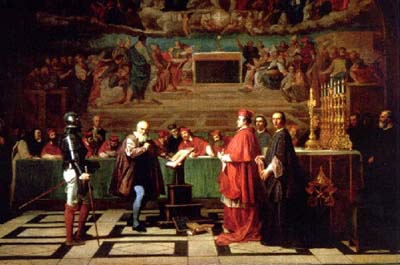
Galileo at the process of the Inquistition |
Prof. Nicola Cabibbo, ex-president of the Italian Institute of Nuclear Physics summarized the case: “Galileo was not condemned for his scientific theses, but because he wanted to formulate theology” (19).
Therefore, there is no reason to say that the Inquisition and the Church erred when they condemned Galileo. There is even less reason to say that such condemnation demonstrates the Church is not infallible. Also, the hasty consequence that the door should open to a scientific interpretation of Scripture is not conclusive.
Science lacks the competence to interpret Sacred Scripture; if it were otherwise, we would end by denying all the revealed mysteries, which are far beyond the capacity of physical and experimental sciences to explain. To introduce scientific criticism in questions of Faith would be to reduce them to human stature, which is the same as denying them.
17. Joseph Ratzinger, Corriere della Sera, March 30, 1990; 30 Dias, January 1993, p. 34.
18. Vittorio Messori, Avvenire, October 19, 1989.
19. Nicola Cabibbo, 30 Dias, January 1993, p. 33.
The Conciliar Church endorsed the revolutionary myths about Galileo
Notwithstanding this status quaestionis [state of the question], Gaudium et spes, the Pastoral Constitution of Vatican Council II, “deplored” the condemnation issued by the Inquisition against Galileo, in this way giving a powerful support to the revolutionary myths. The following paragraph is considered a mention to Galileo’s condemnation:
“The humble and persevering investigator of the secrets of nature is being led, as it were, by the hand of God, the conserver of all things, who made them what they are. We cannot but deplore certain attitudes, not unknown among Christians, deriving from a shortsighted view of the legitimate autonomy of science; they have occasioned conflict and controversy and have misled many into opposing faith and science” (GS n. 36b)
In one of the few footnotes of the 16 conciliar documents, Gaudium et spes recommends to the reader the then recently published work Vita e opera di Galileo Galilei [Life and Works of Galileo] by Pio Paschini (2 vols., Editrice Vaticana, 1964). It was the way the Bishops found to say that the non-specific quoted text should be understood as referring to Galileo.
John Paul II took the same path of reinforcing the revolutionary myth about Galileo when he criticized the attitude of the Church regarding the scientist on several occasions. First, he issued a vague critique on November 10, 1979 in the speech to the Pontifical Academy of Sciences in which he established the commission to study Galileo’s case. Addressing the international scientific community, he stated:
“I desire that theologians, scientists, and historians, in a spirit of open collaboration, profoundly examine the case of Galileo and honestly recognized the errors of any party, and extinguish those suspicions that impede a fruitful concord between science and faith, between the Church and the world” (20).
Second, on September 22, 1989, when visiting the city of Pisa, he issued an indirect acerbic critique of the past condemnation of the Church: “Galileo, an example for all, and also for the Church” (21).
Third, during that same visit, he put aside the indirect allusions, and directly and rudely condemned the behavior of the Church. He said:
“Galileo Galilei, whose scientific work was in its beginning improvidently attacked, today is recognized by all as an essential step in the methodology of research, and generally as an essential step along the road of knowledge about the world of nature” (22).
This statement, considered “definitive” by the Vatican spokesman (23), raised the enthusiastic applause of revolutionaries and progressivists, and the chagrin of those charged with the impartial study. In fact, Cardinal Paul Poupard, head of the commission of studies on the condemnation of Galileo, admitted: “I don’t know if the commission still exists …. I believe that the task is over” (24).
20. John Paul II, apud La Repubblica, September 23, 1989; Corriere della Sera, March 30, 1990.
21. John Paul II, La Repubblica, September 23, 1989.
22. John Paul II, Insegnamenti di Giovanni Paolo II, vol. 12-2, 1989; Libreria Editrice Vaticana, 1991, p. 585.
23. Navarro-Valls, press conference, Corriere della Sera, March 30, 1990.
24. Paul Poupard, Corriere della Sera, March 30, 1990.
The swan’s song of the myth
Despite the haste of John Paul II who “definitively” judged on the topic before the end of the scientific study, Cardinal Poupard presented the final results of the research on October 31, 1992. Under such powerful papal pressure, it is not surprising that Poupard tried as much as possible to tailor the commission’s conclusions to fit the previous partial judgment of JPII. The Cardinal stressed the “relative character” of the condemnation of Galileo and touched superficially on the essential points of the issue. He affirmed:
“The philosophical and theological qualifications, abusively attributed to the new theories regarding the centrality of the sun and the mobility of earth, were the consequence of a period of transition in the realm of the knowledge of astronomy, and an exegetical confusion regarding cosmology” (25).
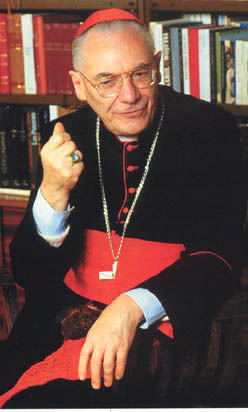
Card. Poupard tailored the conclusions of the commission to please JPII - Inside the Vatican, March 1996 |
He concluded that those who condemned Galileo had committed a “subjective error of judgment.” He ended his statement with words that revealed he was working under pressure: “We need to recognize these errors as Your Holiness asked” (26).
Actually this judgment is incomplete: it is partially right and partially wrong. It has been generally admitted in scholarly milieus that both parties in the controversy had gone beyond the realm of science. For Poupard to say that the Catholic party had been imprecise (“abusive”) seems a banality just to please JPII. I do not note in his words, however, an impartial concern to explain the intention of both sides in order to clarify who was guilty and who was innocent. Above all, the Poupard’s conclusion failed to address the core of the problem.
In a certain way the issue at the heart of the problem was dealt with by John Paul II. At the same plenary meeting of the Pontifical Academy of Science, he read a speech in which he admitted he was no longer able to sustain the “definitive” judgment he had pronounced in Parma. He was obliged to recognize that there was a general confusion regarding science and philosophy in the 17th century. He said:
“Like the majority of his adversaries, Galileo did not make a distinction between what is the scientific focus of the natural phenomena and the philosophical considerations about nature that generally follows it” (27).
Although his speech was entirely favorable to Galileo and against the past decision of the Church, John Paul II had to acknowledge this fundamental error of Galileo. Doing this, in my opinion, he shattered the very myth of which he had been the chief supporter. Actually, if one admits that Galileo as well as the members of the Inquisition were confusing the terms science and philosophy, any serious student of History can understand that Galileo went beyond his competence by pretending to decide what should or shouldn’t be accepted in philosophy – as well as in theology. Then, to see that he deserved correction and condemnation is not a long step to take.

The apologies for Galileo made by John Paul II contrast with the conclusions of the most credible scholars |
What obliged John Paul II to make such a reversal on his former pronouncements? In my opinion, it is probable that serious scholars on the Galileo study commission closed the question. As we have seen in this article, it is almost impossible to deny the historic reality that Galileo was not condemned for his science. So, John Paul II faced a dilemma: either his partiality in the case would be publicly exposed or he had to recognize the essence of the problem.
After that, the myth was as good as dead. It is still being spread by progressivists and other revolutionaries, but it lost its credence in the scholarly sphere. Today the weapons to extirpate the Galileo myth are available to any Catholic who wants to clarify the issue in his various circles..
The speech of JPII was planned to be a solemn glorification of Galileo by a Pope. It maintained all the appearances of doing exactly that, but, in reality, it killed the myth. It was the swan’s song of the myth.
Notwithstanding, the media trumpeted a triumph for Galileo by emphasizing the progressivist criticisms of JPII and Poupard about the Inquisition. In this respect, Italian philosopher Emmanuelle Severino shrewdly remarked upon the contradictory position of the Church:
“By making a mea culpa about Galileo, the Church attributes to science an absolute value at exactly the moment when science is recognizing that, in fact, it does not have truths that are absolute and undisputable” (28).
A final irony that reveals another failure of the progressivists.
25. Paul Poupard, L’Osservatore Romano, November 2-3, 1992.
26. Ibid.
27. John Paul II, L’Osservatore Romano, November 1, 1992.
28. Emanuele Severino, 30 Dias, January 1993, p. 33.

Posted October 6, 2004
|
History | Home | Books | CDs | Search | Contact Us | Donate

© 2002- Tradition in Action, Inc. All Rights Reserved
|
 |
|